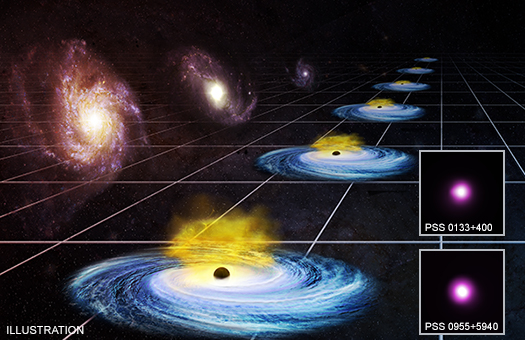Dark Energy Gets Weirder: Mysterious Force May Vary Over Time
Dark energy is apparently even more mysterious than astronomers had thought.
Scientists first proposed the existence of this invisible force two decades ago, to explain the surprising discovery that the universe's expansion is accelerating. (Surprising and incredibly important; the find netted three researchers the Nobel Prize in physics in 2011.)
The most-used astrophysical model of the universe's structure and evolution regards dark energy as a constant. Indeed, many astronomers believe it to be the cosmological constant, which Einstein posited in 1917 as part of his theory of general relativity. [The History & Structure of the Universe in Pictures]
But a new study of enormous, superbright black holes known as quasars suggests that dark energy could be miscast as the cosmological constant, or any kind of constant; the force may have varied since the universe's birth 13.8 billion years ago, research team members said.
"We observed quasars back to just a billion years after the Big Bang, and found that the universe's expansion rate up to the present day was faster than we expected," study lead author Guido Risaliti, of the University of Florence in Italy, said in a statement. "This could mean dark energy is getting stronger as the cosmos grows older."
Quasars are fast-growing supermassive black holes at the hearts of galaxies. Quasars' incredible luminosity — they're the brightest objects in the universe — originates in the disks of material that swirl around the black holes. These fast-spinning disks generate huge amounts of ultraviolet (UV) light, some of which slams into electrons in nearby clouds of hot gas. Such interactions can ramp up the UV radiation to X-ray levels, producing a powerful glow across multiple wavelengths of high-energy light.
The correlation between these two types of light can reveal the distance to a quasar, Risaliti and co-author Elisabetta Lusso, of Durham University in England, determined. In the new study, the duo examined this relationship for nearly 1,600 quasars. They used NASA's Chandra X-ray Observatory and the European Space Agency's XMM-Newton spacecraft to observe the quasars' X-ray light, and the ground-based Sloan Digital Sky Survey to analyze the objects' UV output.
Breaking space news, the latest updates on rocket launches, skywatching events and more!
Risaliti and Lusso found many of the quasars to be incredibly distant. The most far-flung one, for example, was blasting out huge amounts of light into the cosmos just 1.1 billion years after the Big Bang.
Previous work on the universe's expansion rate — including the landmark late-1990s studies that introduced the concept of dark energy — have generally relied on observations of supernova explosions as "standard candles." Researchers determined the distances to these objects, whose intrinsic brightness is known, and figured out how fast they're moving relative to Earth by analyzing how much their light is "redshifted" (stretched to longer wavelengths).
Supernovas, while dramatic and powerful, are much less luminous than quasars and therefore cannot be observed from as far away. So, the new study gives researchers another standard candle, which can be used to assess the universe's expansion across a broader stretch of time.
But Risaliti and Lusso looked at some supernova measurements as well.
"Since this is a new technique, we took extra steps to show that this method gives us reliable results," Lusso said in the same statement. "We showed that results from our technique match up with those from supernova measurements over the last 9 billion years, giving us confidence that our results are reliable at even earlier times."
The new results are consistent with some earlier observations of relatively nearby supernovas. That previous work found an apparently accelerated expansion rate, compared to that of the early universe (as derived from measurements of the cosmic microwave background, the ancient light left over from the Big Bang).
"Some scientists suggested that new physics might be needed to explain this discrepancy, including the possibility that dark energy is growing in strength," Risaliti said. "Our new results agree with this suggestion."
The new study was published online Monday (Jan. 28) in the journal Nature Astronomy. You can read it for free at the online preprint site arXiv.org.
Mike Wall's book about the search for alien life, "Out There" (Grand Central Publishing, 2018; illustrated by Karl Tate) is out now. Follow him on Twitter @michaeldwall. Follow us @Spacedotcom or Facebook. Originally published on Space.com.

Michael Wall is a Senior Space Writer with Space.com and joined the team in 2010. He primarily covers exoplanets, spaceflight and military space, but has been known to dabble in the space art beat. His book about the search for alien life, "Out There," was published on Nov. 13, 2018. Before becoming a science writer, Michael worked as a herpetologist and wildlife biologist. He has a Ph.D. in evolutionary biology from the University of Sydney, Australia, a bachelor's degree from the University of Arizona, and a graduate certificate in science writing from the University of California, Santa Cruz. To find out what his latest project is, you can follow Michael on Twitter.


